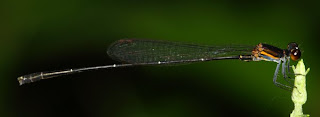I have been trying hard to have a good picture of tandem pair of
Ceriagrion chaoi, and most of the time, I would have the male in focus but the female out of focus or vise versa (
click here to see photos I took previously). Now I have a photo of tandem pair
C. chaoi with both the male and female in focus. My next task, of course, will be taking photos of
C. chaoi in wheel. Strangely, I have not yet seen a wheel pair of
C. chaoi though I have been spotting this species on regular basis.















































